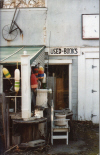The Ledge – Winter 2013
The Ledge, lyrical and relentlessly beautiful, may lead a reader safely away from any kind of cliff or precipice, despite the suggestion of its title. The connotation for this volume does ring true if one reads ‘ledge’ as an embodiment of ‘edgy,’ but not with the metaphor of a natural feature entailing the risk of falling. The work is precise and challenging and invites further consideration; I examine a few especially rich works here.
The Ledge, lyrical and relentlessly beautiful, may lead a reader safely away from any kind of cliff or precipice, despite the suggestion of its title. The connotation for this volume does ring true if one reads ‘ledge’ as an embodiment of ‘edgy,’ but not with the metaphor of a natural feature entailing the risk of falling. The work is precise and challenging and invites further consideration; I examine a few especially rich works here.
During the final years of the War in the Pacific, with his A6M Zero fighter aircraft steaming in the wing, a young aviator contemplates fulfilling the suicide mission of Tokko Tai in Takamichi Okubo’s “Dear Mother.” Kazunari has initiated the attack three times, and returned three times. His decision to fly the plane back to Japan without sacrificing himself against the Allied warships has rendered him almost a pariah. And yet, as one might expect from a man contemplating the end of his life, he is not thinking of fuel tanks and torpedoes, nationalism or just war theories. He is not thinking of the woman who gave life to him or to whom he dedicates his love at the end of it.
The story excels and exceeds expectations on a few levels. The characterization of the aviator facing a “special attack” mission is fascinating – not in an exotic sense, a strange, zebrafish kind of showcase. Instead, it is fascinating because the writer compels you to experience acute empathy with the protagonist.
Classic immersion aside, the story of the friendship of this young man as a boy and his stepmother is heart-wrenching. It complicates whatever automatic reaction we might have to the Tokko Tai because this is no longer a war story, it is a love story. And although you may consider yourself a bulwark against such a story for your political convictions, as I did, you will also have felt the breath of a coerced and conscripted man against your eyelids, and know that behind the airplane glittering glass sits a man who, up to the present, is not capable of hatred, but rather is capable of the most decent, elemental love.
The subject matter of family plays a key role in other stories in the collection. Take Sean Padraic McCarthy’s short story “The Den.” It’s a brilliant weave of humor and tease and politics, kind of like what you’d expect from David Sedaris if he were writing fiction or at least making a go of it in the third person:
Jack had four sisters . . . Their mother had made a roast, and she poured the roast juice into a cup for Jack’s younger brother, Connor, who liked to drink it. Connor was three, and his mother told him the juice would make him strong, but Jack’s sisters thought the practice was disgusting and made their opinions known every time, getting their father in a bad mood, and Jack didn’t want to make it worse. Christopher had already given his piece of meat to the dog, and that, too, made their father crazy. Crazy for their father usually just meant snapping a little, and then going off to bed.
The story balances exposition, dialogue, and judicious description in perfect pacing, cumulating with a kind of literal and metaphorical darkness, and all of the ways that innocence can be cheapened, if not packed up and sent far away for good.
The Ledge is a readable collection. A particularly good example is Ellen Prentiss Campbell’s “Chinese Vermilion.” Within three paragraphs, the reader knows who the key characters are and what some of the plot complications could be. The reason the clip is so functional is because the story is ultimately much deeper—we segue backwards to a different world by page three, and from there the author excels at balancing the past and present until she neatly lets her nut graph complete the recollection:
Later, over a second beer, I picked up the newspaper and read an article about a neuroscientist studying grief. In brain scans, a specific site lights up, activated by mourning; new loss starts all the old hurts throbbing . . .
But, finally, the disaster was in us, not out there . . . Now I wanted it back; I wanted everything back.
Writers get away with a lot of telling when they approximate a memoir or an essay, but sometimes philosophical context is welcome as it is in Campbell’s piece. Not every rainy day is a prescription for Finnegan’s Wake, and sometimes the innovation of today is sufficient to pass the trembling afternoons of the future.
[www.theledgemagazine.com]





